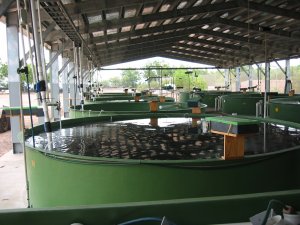|
19 September 2025
|
|
|
മലയാളം
|
|
|
|
|
|
Larval Rearing
The larvae and post larvae are reared at first in indoor tanks until they metamorphose
into fry at about the 20th day after hatching. Larvae are stocked @ 30-40 nos./litre
in fibre glass/RCC rectangular tanks of 4-5 tonne capacity. Larvae thrive on the
yolk for the first 3 days. The 3-day old larvae should be fed with rotifers (Brachionus
plicatilis) @ 2 nos./ml initially and gradually increased to 5 nos./ml
till 8th day. From 9th day onwards, larvae should be fed with 5 nos./ml. rotifer
and Artemia nauplii. Artemia nauplii density should be maintained @ 1 no./ml
initially and increased to 3 nos./ml upto 15th day. From 16th day to 25th day, larvae
should be exclusively fed with Artemia nauplii at a density of 4-5 nos./ml.
All the feeds should be given in 4 doses at an interval of 6 hrs. After 20 days
the larvae metamorphose into fry. The survival rate from hatching to fry stage is
about 35-42%.
Nursery rearing
Nursery rearing of seabass fry in ponds and cages to stockable juvenile size is
essential before release into the grow-out ponds. Nursery ponds may range in size
from 500-2000 m2. A water depth of 50-80 cm is desirable. In a prepared
nursery pond, fry of 1.0 to 2.5 cm size can be stocked @ 20-50 nos./m2.
Water exchange to the extent of 30% is required daily. Fry must be fed with supplementary
feed of chopped and ground fish (4-6 mm size) @ 100% of the body weight, twice a
day, in the first week. The feeding rate is gradually reduced to 60% and 40% during
second and third week respectively. Though seabass prefers live fish food it could
be weaned to trash fish within 5-7 days. The nursery-rearing period is about 30-45
days.
On 25th day, the fry measures 1.0 cm, which should be transferred to nursery tanks
in the hatchery or nursery hapas at the farm site. Fry are stocked @ 1000 nos./m3
in 4-5 tonne capacity tanks. The cooked and minced fish meat, made into small pieces
of 1.5-2.5 mm, should be given as feed ad libitum during the nursery rearing.
Grading (removal of shooter fish) should be done on alternative days to reduce cannibalism.
In the case of rearing seabass in the hapas (2m x 2m x 1m size), fry should be stocked
@ 500 nos./m2. Feeding and grading should be done as in the case of tank
rearing. The expected survival rate would be 80-86% with an average size of 1.25g
in 30-35 days of rearing in the tank or hapa. Nursery cage size may range from 3
m (3x1x1 m) to 10 m (5 x 2 x 1 m) with a mesh size of 1 mm. Stocking density with
fry of size range 1.0 - 2.5 cm may vary from 80-100 nos./m. Feeding schedule to
be followed as in pond rearing. Cages should be checked and cleaned regularly. The
fry on reaching a size of 5-10 g at the end of a rearing period of 30-45 days can
be stocked in the grow-out system. Usually a survival rate ranging from 50-70% could
be obtained.

Larval rearing tanks
Top
|
|
|
|
|
|